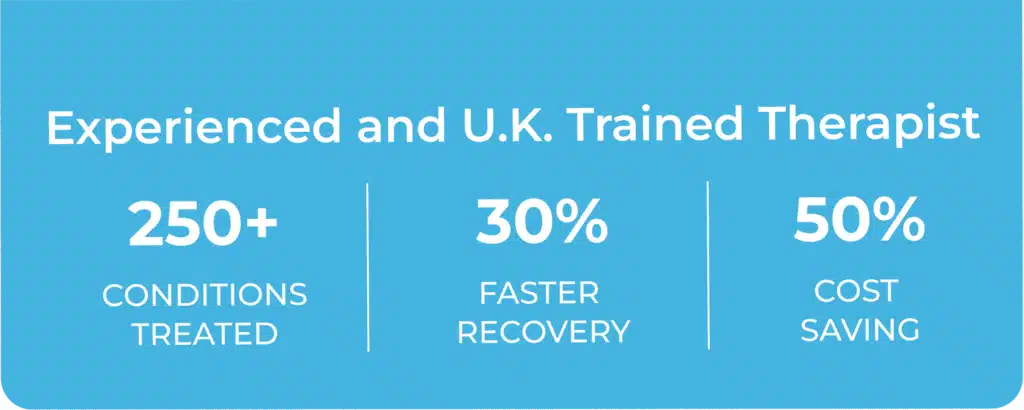
Many people think sciatica is just regular back pain, but starting physiotherapy early can really help. Gentle exercises, posture guidance, and targeted stretches reduce pain and improve mobility.”
Ashish, 42 from Mumbai, had chronic sciatica from a herniated disc. After 6 weeks of online sciatica physiotherapy, his pain reduced by 65%, and he could walk, bend, and sit comfortably again.
This shows how sciatica physiotherapy online can restore movement and ease pain — all from the comfort of your home.
Do you often feel a sharp or burning pain that travels from your lower back to your leg? This pain might be sciatica — a problem that happens when the sciatic nerve gets pressed or irritated. It can make daily activities like walking, sitting, or bending very painful.
The good news is that physiotherapy for sciatica can help you heal naturally. With the right sciatica physiotherapy treatment, you can reduce pain, move better, and stop the pain from coming back — all without surgery or strong medicines.
Physiotherapists use safe exercises, posture correction, and gentle stretching to relax tight muscles and ease pressure on the nerve. Over time, this sciatica physical therapy improves strength, flexibility, and confidence in your movement.
Sciatica is pain caused by irritation or compression of your sciatic nerve, the longest and thickest nerve in your body — about 2 centimeters wide, similar to a U.S. penny or a UK 1 pence coin. This nerve runs from your lower back, through your buttocks, and down each leg to your feet and toes.
When the sciatic nerve is affected, you may experience:
Key Facts:
Tip: Regular physiotherapy for sciatica can reduce pain and improve movement. Consistent use of sciatica physiotherapy treatment helps prevent flare-ups, while exercises from sciatica physical therapy programs keep your legs and back strong.
There are two main types of sciatica. Both can cause pain, numbness, or tingling along the leg, but the cause is different.
Note: Most doctors call both types simply “sciatica.” The difference matters when choosing the right physiotherapy for sciatica or sciatica physical therapy treatment.
Tip: Early sciatica physiotherapy treatment can reduce pain, improve movement, and prevent the problem from getting worse.
Sciatica usually starts as pain in your lower back or buttocks and can travel down your leg. Common signs include:
Most people feel these symptoms in one leg, but sometimes both legs can be affected. Sciatica pain may begin suddenly or slowly, depending on the cause.
Tip: Early sciatica physiotherapy treatment can help reduce pain, improve leg and back mobility, and prevent the problem from coming back.
Sciatica happens when the sciatic nerve is pinched or irritated. Some common causes include:
Other risk factors: Sitting for long periods, poor posture, being overweight, and not exercising enough can make sciatica more likely.
Using physiotherapy for sciatica and following a sciatica physical therapy plan can reduce pressure on the nerve, strengthen your muscles, and help you stay active without surgery.
Unlike medicines that only hide pain, physiotherapy for sciatica works on the root cause. Weak muscles, poor posture, and nerve pressure are treated directly. A trained physiotherapist helps you move better, strengthens your muscles, and eases pressure on the sciatic nerve.
Key Benefits of Sciatica Physiotherapy Treatment:
Consistent sciatica physical therapy exercises make a big difference. Even a few minutes every day can improve mobility and reduce pain safely.
Sciatica physical therapy is designed to help your lower back, hips, abdomen, buttocks, and thighs recover from nerve pain. The exercises aren’t just about moving—they target the root causes of sciatica like weak muscles, poor posture, and nerve compression. Here’s what these exercises aim to achieve:
Tip: Consistency is the secret. Doing these sciatica physiotherapy exercises even for 10–15 minutes daily can improve flexibility, reduce pain, and keep your body strong. Over time, it helps you regain confidence in movement and prevents recurring sciatica flare-ups.
Leading physiotherapy experts in 2025 recommend a multimodal approach to manage and prevent sciatica effectively. This means combining different strategies for faster recovery, long-term pain relief, and improved mobility.
Tip: Combining these approaches makes physiotherapy for sciatica more effective than using just one method. Regular exercise, proper posture, and professional guidance are key to staying pain-free in 2025
Physiotherapy for Sciatica is one of the most effective, non-surgical ways to relieve lower back pain and leg discomfort caused by sciatic nerve compression. With today’s digital care options, sciatica physiotherapy can now be done comfortably from home through online sessions, guided step-by-step by certified experts.
The treatment focuses on relieving nerve pressure, improving flexibility, and strengthening the lower back and leg muscles for long-term pain prevention.
Here’s a look at the three-stage sciatica physiotherapy treatment plan followed by most specialists:

The first session helps identify the root cause of your sciatica pain and design a safe, personalized plan.
Posture and spine alignment check via video consultation
Review of your sitting posture, daily habits, and sleeping position
Customized sciatica exercise plan based on pain level and movement limitations
Expert advice on do’s and don’ts for sciatica, including proper ergonomics and stretching routines
Once your assessment is complete, the focus shifts to reducing nerve compression, inflammation, and muscle stiffness through guided therapy:
Sciatica stretching exercises for the lower back, hips, and legs
Heat or cold therapy guidance for home pain relief
Posture retraining and ergonomic corrections for long sitting hours
Gentle myofascial release and nerve-gliding techniques to relax tight muscles and restore normal motion


After the pain subsides, your physiotherapist shifts focus toward strengthening and stability to prevent recurrence.
Core and lower-back strengthening exercises to support spinal alignment
Hip and leg muscle activation for better movement control
Relaxation and deep-breathing techniques to release tension and improve circulation
Home exercise plan for sciatica — daily routines to maintain flexibility and protect the spine
Every session is personalized and monitored online by a physiotherapist, ensuring safe, effective, and consistent care without leaving home.
Patient: Rajesh Kumar, 42, Mumbai
Condition: Chronic sciatica caused by a herniated disc
Rajesh had been struggling with severe leg pain and limited mobility for months. Simple tasks like walking, sitting, or bending were painful, and he wanted a non-surgical solution.
He joined an online sciatica physiotherapy program, which included guided exercises, posture correction, and regular virtual check-ins with a trained physiotherapist.
After just 6 weeks of consistent practice:
Rajesh shares, “Even through online sessions, it felt like my physiotherapist was right there, guiding me, correcting my movements, and giving constant encouragement. I finally feel in control of my pain.”
This story highlights how sciatica physiotherapy, even online, can provide safe, effective relief without surgery, while strengthening muscles and improving mobility.
It’s important to get professional help if your sciatica symptoms are severe. Contact a physiotherapist or doctor immediately if you notice:
These signs may mean the sciatic nerve is seriously affected and need prompt medical attention. Early intervention can prevent further nerve damage and help you recover faster with proper physiotherapy.
Also Read: Physiotherapy For Back Pain ; Physiotherapy For Knee Pain
These exercises are safe, effective, and commonly included in sciatica physical therapy treatment. Perform them under guidance initially, then at home consistently.
This exercise gently stretches your lower back while helping reduce pressure on the sciatic nerve. It strengthens the muscles supporting your spine and improves mobility, making daily tasks like bending or standing easier. Practicing this regularly is a key part of sciatica physiotherapy treatment.
How to Perform:
Benefits:
This stretch targets your lower back and glute muscles, easing tightness that can irritate the sciatic nerve. It increases flexibility in your spine and hips, helping you move with less pain. Including it in your sciatica physical therapy plan can help you recover faster.
How to Perform:
Benefits:
A strong core is essential for supporting your lower back and relieving stress on the sciatic nerve. The plank strengthens abdominal and spinal muscles, improving posture and helping prevent future sciatica flare-ups. It is a cornerstone of physiotherapy for sciatica.
How to Perform:
Benefits:
This exercise strengthens your glutes, lower back, and core, which helps support the spine and reduce sciatic nerve irritation. It also improves posture and stability, making movements like walking or climbing stairs more comfortable.
How to Perform:
Benefits:
This exercise stretches your hamstrings and reduces tension on the sciatic nerve. It helps improve leg flexibility and can reduce tingling or numbness in your legs. Straight leg raises are an important part of sciatica physiotherapy exercises.
How to Perform:
Benefits:
This exercise encourages smooth movement of the sciatic nerve and reduces irritation. It improves leg mobility and helps your nervous system adapt, making it easier to do daily activities without pain.
How to Perform:
Benefits:
Tight piriformis muscles can press on the sciatic nerve and cause pain in your buttocks and legs. This stretch helps relax the piriformis, improves hip mobility, and reduces pressure on the nerve. It is an effective exercise in sciatica physical therapy treatment.
How to Perform:
Benefits:
Tight hamstrings can worsen sciatic nerve pain. This stretch gently loosens your hamstrings, improves leg mobility, and reduces tension in your lower back. Regular hamstring stretches support overall recovery in sciatica physiotherapy.
How to Perform:
Benefits:
This movement improves spine mobility, loosens tight muscles, and reduces stiffness in your back. It teaches your spine to move safely and helps decrease irritation on the sciatic nerve, making it a key exercise for sciatica physical therapy.
How to Perform:
Benefits:
This exercise stretches your lower back and hips, easing tension around the sciatic nerve. It is simple but effective for relieving pain and improving spinal flexibility as part of a sciatica physiotherapy program.
How to Perform:
Benefits:
Also Read: Physiotherapy For Joint Pain ; Physiotherapy For Disc Burge
Resolve360 delivers specialized sciatica physiotherapy aimed at reducing pain, restoring mobility, and preventing future flare-ups — all without surgery or heavy medication. Here’s why thousands of patients trust us for their recovery:
Certified Physiotherapy Experts: Our team of experienced physiotherapists creates personalized treatment plans based on your specific sciatica symptoms, ensuring safe and effective care.
Tailored Exercise Programs: Every exercise and stretch is customized to your pain level, flexibility, and lifestyle, helping you recover efficiently while preventing recurrence.
Convenient Online Physiotherapy: Receive expert guidance from the comfort of your home, whether you’re in India, the USA, or the UK. No commuting, no waiting rooms — just professional care at your fingertips.
Progress Monitoring & Feedback: Regular online check-ins allow our physiotherapists to track your improvement, modify exercises as needed, and ensure consistent progress toward a pain-free life.
Safe, Non-Surgical Approach: Our programs focus on relieving sciatic nerve pressure, strengthening core and gluteal muscles, and improving posture naturally, reducing the need for invasive procedures or long-term medications.
Education & Ongoing Support: Learn proper movement techniques, posture habits, and self-care strategies to manage symptoms effectively and prevent future flare-ups.
With Resolve360’s online physiotherapy services, you receive comprehensive sciatica physical therapy that combines professional expertise, convenience, and evidence-based exercises — helping you regain mobility, reduce pain, and improve your overall quality of life.
With sciatica physiotherapy, you can reduce pain, restore movement, and improve your quality of life. Consistency is key — even 10–15 minutes of daily guided exercises makes a difference.
Take control of your sciatica today — start your personalized online physiotherapy program with Resolve360 and move pain-free again!
Book an online physiotherapy consultation today to receive a personalized exercise plan, posture guidance, and professional support — all from the comfort of your home.
Yes. Physiotherapy for sciatica targets nerve compression, strengthens core and glute muscles, stretches tight hamstrings and piriformis, and corrects posture, reducing pain and improving mobility. Regular guided exercises prevent future sciatica flare-ups safely.
The most effective treatment combines sciatica physiotherapy treatment with stretching, core and glute strengthening, nerve gliding, posture correction, and low-impact aerobic exercises. Guided physiotherapy ensures safe, long-lasting relief.
A physiotherapist performs a detailed assessment, prescribes sciatica physical therapy exercises, applies nerve mobilization techniques, corrects posture, and strengthens the lumbar spine, hips, and core, helping reduce pain and restore normal function.
Immediate relief comes from physical therapy for sciatica, including gentle stretches, nerve glides, prone press-ups, core and glute strengthening, and ergonomic adjustments. Consistency is key for lasting pain reduction.
Yes. Long-term sciatica physiotherapy improves spinal alignment, strengthens supporting muscles, relieves nerve irritation, and enhances mobility, significantly reducing chronic pain without relying on surgery or heavy medication.
Prone press-ups (back extension) and sciatic nerve mobilization are highly recommended. These exercises relieve nerve pressure, stretch the lumbar spine, and improve leg flexibility as part of a full sciatica physiotherapy treatment.
In most cases, yes. Physiotherapy for sciatica addresses the root cause of nerve compression, improves muscle strength and flexibility, corrects posture, and prevents recurrence, reducing the need for surgical intervention.
Nerve gliding or sciatic nerve mobilization is considered a miracle exercise. It gently stretches the sciatic nerve, relieves pressure, reduces pain, and improves leg mobility when combined with core and glute strengthening.
Most patients notice improvement within 4–6 weeks of consistent sciatica physical therapy, including stretches, core exercises, and posture correction. Regular adherence ensures faster relief and long-term mobility benefits.
A physiotherapist evaluates posture, spine, and nerve compression, prescribes physical therapy for sciatica, teaches targeted exercises, and monitors progress to relieve pain, improve flexibility, and prevent future flare-ups safely at home.

Dr. Nidhi Kumari
She has persuaded her bachelor’s from SGT University, Gurugram, she has done her internship at Dr. Ram Manohar Lohia Hospital, and persuade her Master in Physiotherapy from Chaudhary Charan Singh University, Meerut. She has previously worked with Orthocure clinic, Dr.Nasir physiotherapy rehabilitation, Quantum physiotherapy, and wellness center.
If you have more questions.

Dr. Nidhi
She has persuaded her bachelor’s from SGT University, Gurugram, she has done her internship at Dr. Ram Manohar Lohia Hospital, and persuade her Master in Physiotherapy from Chaudhary Charan Singh University, Meerut. She has previously worked with Orthocure clinic, Dr.Nasir physiotherapy rehabilitation, Quantum physiotherapy, and wellness center.
If you have more questions.




























Also Read: Back Pain: Causes and Treatment
If you would like to know more about any of the health conditions, please fill up the form below and talk to Doctors on Resolve360 directly by asking a question.
We are your doctor’s first choice and trusted by 50,000+ patients.



We are your doctor’s first choice and trusted by 50,000+ patients.

We are your doctor’s first choice and trusted by 50,000+ patients.

Resolve360 is great platform for online physiotherapy.
I was suffering from scapula dyskinesia and had lot of pain in right shoulder movement. I was introduced to Resolve 360 by my oncologist.
Within a month (26 sessions) there was a considerable improvement. Sessions are very cost-effective and doctors are very kind and efficient.
Doctor David has been really great and helpful. I would highly recommend Resolve 360.


I took prenatal care program from Resolve 360. Dr. Preyrna was assigned to me and she has done commendable job. I did prenatal exercises under her supervision, she designed program according to my body need. With her help my pregnancy was healthy and I got good dilations at the time of delivery. I am blessed with a healthy baby girl and very happy with Resolve 360.


Best therapy sessions that too at home and timings are very flexible. I had a issue in my neck and lower back since almost 4 to 5 years, taken so many treatments and physio sessions. But all gave a temporary relief. Then my friend referred me this Resolve 360 in 2020, in starting i was hesitant as everything was online, but after taking almost 10 sessions i got much relief, and now i am almost free of pain. Thanks to the team of Resolve 360.












I had online Physiotherpy sessions by Prerana for my heel pain. ( Tendo Achilis Sprain).
Though virtual, it was more interactive.
She was very observant throughout the sessions, correcting me while doing the exercises and was assertive in her outlook.
I found her instructions and methodology very helpful. She is updated in her academic knowledge in the field of Physiotherpy. She clarified my doubts about the role of Laser and Ultrasound treatment quoting evidence based data. With my personal experience I agree with her opinion that these are more of placebo effect.
Physiotherpy though not a miracle treatment, is a compelling necessity to most of the musculoskeletal and neurological illnesses. It needs to be accepted as healthy way to live.


From being a couch potato with poor cardio respiratory system to reaching pre-athlete levels of fitness in a span of 3 months, my journey with Resolve360 and Dr.David (Physiotherapist) has been anything but magical!
About 3 to 4 months ago, my blood report showed very high bad cholesterol levels, I was low on stamina and had frequent breathing issues. My GP prescribed me cholesterol meds for a month but I felt that alone wouldn’t get me back in shape because I needed a major lifestyle overhaul.
Dr.David educated me about my condition in detail and where it could lead me to if I don’t take action in the long run. He put me on a balanced workout regime being easy with cardio workouts in the initial days and gradually upgraded it observing me closely. He also advises me on dietary choices and follows up frequently. During the initial days, my ears used to get blocked within 5 wall squats and I stop right away but now I do over 20 in one shot and hardly feel a thing. I used to lose balance and fall off over my face within 6 push-ups or 20 seconds of plank and now I do about 24 push-ups in one shot. My heart rate used to raise above 150 bpm doing jumping jacks or other cardio workout within 20-30 seconds. You won’t believe I don’t do any of these cardio workouts without additional weights on my feet these days and my heart rate and recovery are as steady as they could get. I couldn’t run for over 2 min without stopping and gasping and now I cover about 4.6 km in 30 min and follow-up with a 20 min walk. Not convinced yet? My VO2 Max (I use an Apple Watch to measure this stat) was just about 33 while I started with Resolve360 and David. That reflects a very poor cardio respiratory fitness for a 34 year old. It’s 43.5 today ! Easily above average. Please read upon about VO2 Max and how it directly relates to cardio respiratory fitness so you get an accurate picture about my monumental progress in the last 3 months. I’ve been trying to get into a regular physical workout and balanced diet discipline since my 20s but I’d never been so motivated as I’m now. Give these guys a try. After all, the best investment you could ever make is on your health !


We contacted resolve360 for our child speech issue and I must say Resolve 360 team and Apoorva doing a wonderful job.
Our speech therapist Jaslia from Resolve360 is having a excellent knowledge and it helps our child a lot. Jaslia understand child psychology very well. Due to her efforts, we are seeing tremendous improvements in our child. She has a strong dedication towards her work and her nature towards kids makes her a very special one. She has given us enough confidence, due to her efforts and excellent service, we are seeing good improvements for my child speech & communication skills.
I would highly recommend Jaslia & Resolve360 team for their excellent work. God bless you!!

